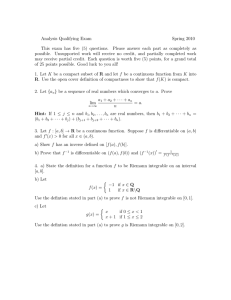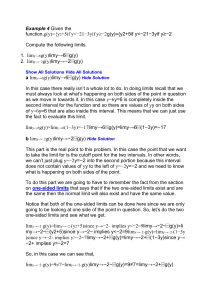Take Home Exam 2 Key
advertisement
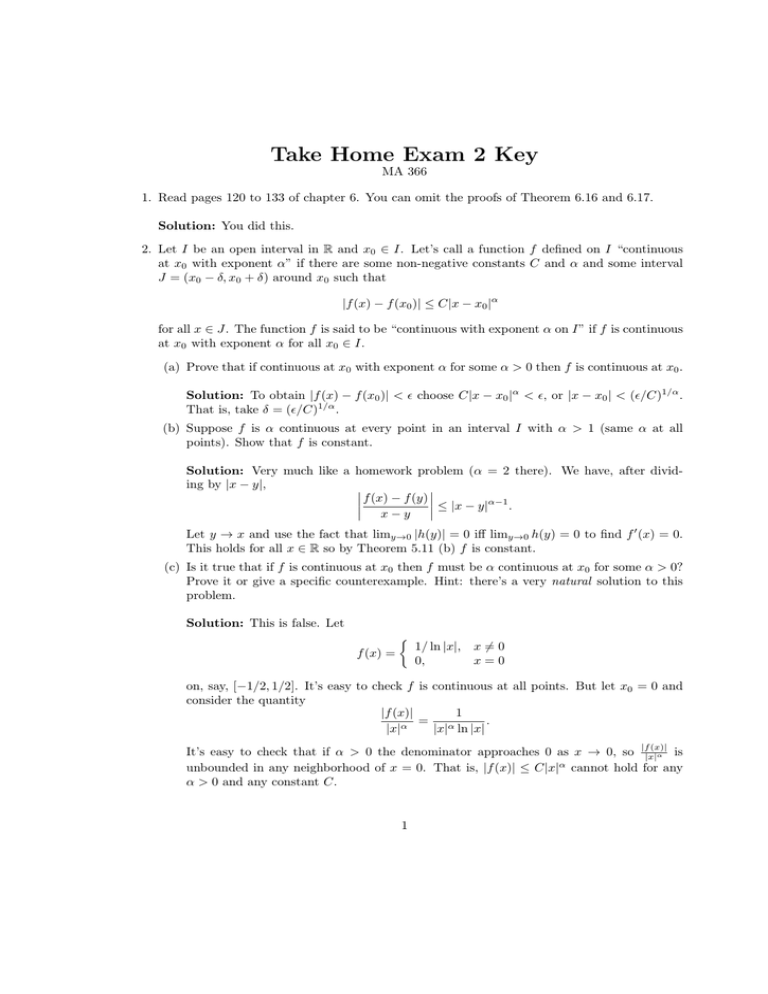
Take Home Exam 2 Key
MA 366
1. Read pages 120 to 133 of chapter 6. You can omit the proofs of Theorem 6.16 and 6.17.
Solution: You did this.
2. Let I be an open interval in R and x0 ∈ I. Let’s call a function f defined on I “continuous
at x0 with exponent α” if there are some non-negative constants C and α and some interval
J = (x0 − δ, x0 + δ) around x0 such that
|f (x) − f (x0 )| ≤ C|x − x0 |α
for all x ∈ J. The function f is said to be “continuous with exponent α on I” if f is continuous
at x0 with exponent α for all x0 ∈ I.
(a) Prove that if continuous at x0 with exponent α for some α > 0 then f is continuous at x0 .
Solution: To obtain |f (x) − f (x0 )| < ϵ choose C|x − x0 |α < ϵ, or |x − x0 | < (ϵ/C)1/α .
That is, take δ = (ϵ/C)1/α .
(b) Suppose f is α continuous at every point in an interval I with α > 1 (same α at all
points). Show that f is constant.
Solution: Very much like a homework problem (α = 2 there). We have, after dividing by |x − y|,
f (x) − f (y) ≤ |x − y|α−1 .
x−y
Let y → x and use the fact that limy→0 |h(y)| = 0 iff limy→0 h(y) = 0 to find f ′ (x) = 0.
This holds for all x ∈ R so by Theorem 5.11 (b) f is constant.
(c) Is it true that if f is continuous at x0 then f must be α continuous at x0 for some α > 0?
Prove it or give a specific counterexample. Hint: there’s a very natural solution to this
problem.
Solution: This is false. Let
{
f (x) =
1/ ln |x|, x ̸= 0
0,
x=0
on, say, [−1/2, 1/2]. It’s easy to check f is continuous at all points. But let x0 = 0 and
consider the quantity
1
|f (x)|
=
.
α
α
|x|
|x| ln |x|
(x)|
It’s easy to check that if α > 0 the denominator approaches 0 as x → 0, so |f|x|
is
α
unbounded in any neighborhood of x = 0. That is, |f (x)| ≤ C|x|α cannot hold for any
α > 0 and any constant C.
1
3. Show that if
∑
n
an converges absolutely then
∑
n
a2n converges.
∑
Solution: Since n an converges absolutely we have |an | → 0. Thus for some N1 we have
|an | ≤ 1 for all n ≥ N1 . This means that a2n ≤ |an | for n ≥ N1 , i.e., the series with terms |an |
dominates the series with terms a2n , and so the latter converges by comparison.
4. Suppose f is continuous on (a, b] and limx→a+ f (x) exists. Show that f is uniformly continuous
on (a, b]. Hint: you may have to extend yourself here.
Solution: Let limx→a+ f (x) = L. Define a new function
{
f (x), a < x ≤ b
f˜(x) =
L,
x=a
In short, f˜ is f extended to [a, b]. Note f˜ is continuous by construction, and so uniformly
continuous. That is, for each ϵ > 0 there is a δ > 0 so that |f˜(x) − f˜(y)| < ϵ for |x − y| < δ.
But since f˜ = f on (a, b] the same δ works for f ! Thus f is uniformly continuous.
5. Show that the function
{
f (x) =
1, if x = 1/n for some n ∈ N
0, else
is Riemann integrable on [0, 1] (with α(x) = x, the usual). (Note that f is neither monotone
nor continuous). Compute the integral of f .
Solution: Lots of ways to do this. For example construct a partition PN with nodes of
the form
PN = {0, 1/N − δ, 1/N + δ, 1/(N − 1) − δ, 1/(N − 1) + δ, . . . , 1/2 − δ, 1/2 + δ, 1 − δ, 1}.
Choose δ < 1/(N − 1) − 1/N = 1/(N 2 − N ) so the nodes as listed above are increasing.
On any interval [xk−1 , xk ] we have inf(f ; [xk−1 , xk ]) = 0, so L(f, PN , x) = 0 for any N . On
the leftmost subinterval we have sup(f, [x0 , x1 ]) = 1, and also the supremum of f is 1 on each
of the N subintervals of the form [1/k − δ, 1/k + δ] for 2 ≤ k ≤ N . The sup is also 1 on the
rightmost subinterval [1 − δ, 1]. All in all we see that
U (f, PN , x) = 1/N + 2δ(N − 1) + δ = 1/N + (2N − 1)δ.
For any ϵ > 0 choose N so that 1/N < ϵ/2 (N > 2/ϵ) and then choose δ < ϵ/(4N − 2). We
find that
U (f, PN , x) < ϵ/2 + (2N − 1)ϵ/(4N − 2) = ϵ.
We can thus make U (f, PN , x)−L(f, PN , x) < ϵ for any ϵ > 0 and so f is integrable. Moreover,
clearly sup L(P, f, x) = 0, so the integral is 0.
2
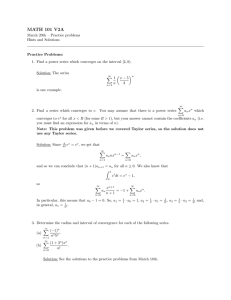
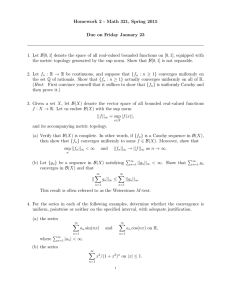
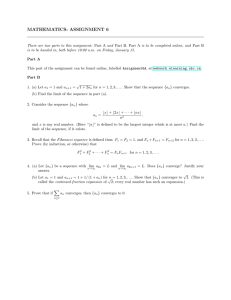


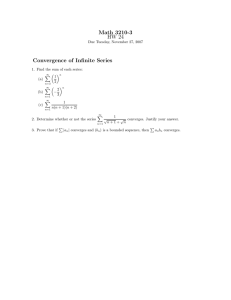
![(1) If f : [0, 1] −→ R is continuous... Z f (x)dx = f (c).](http://s2.studylib.net/store/data/010518093_1-908690675bd939e7f32dbd691b6cbb60-300x300.png)
